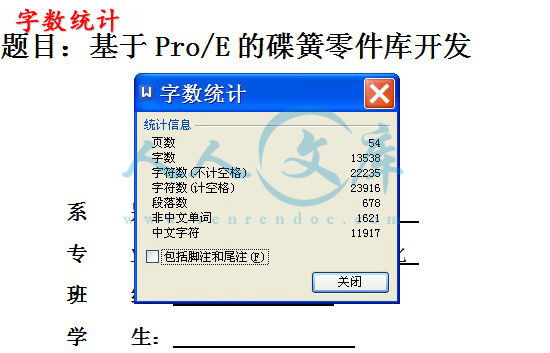【温馨提示】 购买原稿文件请充值后自助下载。
以下预览截图到的都有源文件,图纸是CAD,文档是WORD,下载后即可获得。
预览截图请勿抄袭,原稿文件完整清晰,无水印,可编辑。
有疑问可以咨询QQ:414951605或1304139763
基于Pro/E的碟簧零件库开发
摘 要
本课题针对多种类型碟簧,提出基于Pro/E平台开发交互式3D碟簧零件库的一种可行方案。并且成功开发设计出能满足用户要求的碟簧模型库。
本文首先简单介绍了与本课题相关的Pro/E开发功能,包括自定义菜单的生成、对话框的制作、Pro/TOOLKIT应用程序的执行。其次根据本课题的要求,分析了碟簧开发的整体设计思路。然后以普通碟簧为例,较详细地说明了碟簧零件库的建库过程,并给出了测试实例。最后对开发的三维建模程序进行测试。结果表明:开发程序正确无误,建模迅速,大大提高了这类通用件在Pro/E平台上的设计效率。
关键词:Pro/E;碟簧模型库;Pro/TOOLKIT;零件库
Development of Disc Spring Parts Library Based on Pro/E
Abstract
This article introduces a feasible method of development of the disc springs 3D part library based on Pro/E. And the disc spring parts library is successfully designed meet to the user requirements.
Firstly, this article simply introduces the development functions of Pro/E referring to this task which includes the creation of menu, the creation of the dialogue, the Pro/TOOLKIT procedure execution. Then the precept to the overall design way of disc spring library is analyzed. With an example of disc spring in detail, the development method of the disc springs part library is discussed. At last, the test of all process of three-dimension-part-model driven by database is performed indicates that the program is right, and the model can be set up quickly. The efficiency for the design of interchangeable part based on Pro/E can be increased.
Keywords: Pro/E; Disc spring parts library; Pro/TOOLKIT; Part Library
目 录
1绪论 1
1.1 CAD/CAM的发展现状 1
1.2碟形弹簧简介 2
1.3 课题的提出及意义 3
1.4 预期功能 3
1.5本论文内容 4
2 碟形弹簧零件库总体设计方案 5
2.1 碟形弹簧分类和相关国家标准 5
2.2碟簧零件库的总体结构和建库步骤 6
2.3碟簧零件库的关键技术 6
2.3.1碟形弹簧的Pro/E参数化建模 6
2.3.2碟簧尺寸数据库 7
2.3.3运用Pro/E族表功能建立碟形弹簧3维模型库 7
2.3.4碟簧零件库数据的一致描述 8
2.4开发工具的确定 9
2.5开发环境 11
2.5.1硬件开发环境 11
2.5.2 软件开发环境 12
3 碟形弹簧的结构尺寸数据库的建立 13
3.1结构尺寸数据库的内容 13
3.2碟形弹簧结构尺寸数据的录入 13
3.3建库结果 17
4 碟形弹簧2D结构图的制作 18
4.1 AutoCAD绘图环境设置 18
4.2碟形弹簧二维图绘制的内容和方法 18
4.2.1小图绘制的要求 18
4.2.2大图绘制的要求 18
4.3基于photoshop的碟形弹簧2D结构图制作 19
4.3.1小图具体打印的设置 19
4.3.2大图具体打印的设置 20
4.3.3小图片的photoshop处理 20
4.3.4大图的photoshop处理 23
5 碟形弹簧3D模型库的建立 26
5.1碟形弹簧的参数化建模 26
5.2模型库的建立 28
6 标准件库检索程序的开发和运行 32
6.1发工具简介 32
6.2 Visual C++的ProE二次开发环境配置 33
6.3程序的挂接运行和验证 36
7装配图说明 39
7.1离合器工作原理 39
8结 论 40
参考文献 41
致 谢 42
毕业设计(论文)知识产权声明 43
毕业设计(论文)独创性声明 44
附 录 45
1 绪论
1.1 CAD/CAM的发展现状
CAD/CAM技术作为电子信息技术的重要组成部分,其应用已遍及各个工程领域,是工程设计、产品制造业界的一场革命。经过四十多年的发展,CAD/CAM技术有了长足的进步。以前CAD/CAM技术大都是在工作站平台上运行和开发,随着计算机水平的大幅提高,目前CAD/CAM软件均可以在微机上运行。微机平台为普及CAD的应用创造了绝好的条件。在此基础上,CAD/CAM软件厂商展开了新一轮的竞争。目前CAD/CAM软件动态如下:



 川公网安备: 51019002004831号
川公网安备: 51019002004831号